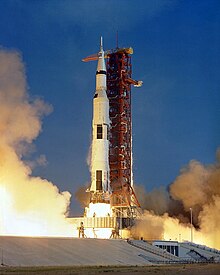
Back Saturn V Afrikaans Saturn V AN ساتورن 5 Arabic Saturn V AST Saturn V Azerbaijani ساتورن ۵ AZB Сатурн V BE-X-OLD Сатурн V Bulgarian স্যাটার্ন ফাইভ Bengali/Bangla Saturn V Catalan
 The launch of Apollo 11 on Saturn V SA-506, July 16, 1969 | |
| Function |
|
|---|---|
| Manufacturer | |
| Country of origin | United States |
| Project cost | US$6.417 billion[1] (equivalent to $50 billion in 2023) |
| Cost per launch | US$185 million[2] (equivalent to $1.451 billion in 2023) |
| Size | |
| Height | 111 m (363 ft) |
| Diameter | 10 m (33 ft) |
| Mass | 2,822,000 to 2,965,000 kg (6,221,000 to 6,537,000 lb)[3] |
| Stages | 3 |
| Capacity | |
| Payload to LEO | |
| Altitude | 170 km (90 nmi) |
| Orbital inclination | 30° |
| Mass | 141,136 kg (311,152 lb)[a][4][5] |
| Payload to TLI | |
| Mass | 52,759 kg (116,314 lb)[6] |
| Associated rockets | |
| Family | Saturn |
| Derivative work | Saturn INT-21 |
| Comparable | |
| Launch history | |
| Status | Retired |
| Launch sites | Kennedy Space Center, LC-39 |
| Total launches | 13 |
| Success(es) | 12 |
| Partial failure(s) | 1 (Apollo 6) |
| First flight | November 9, 1967 (AS-501 Apollo 4)[b][7] |
| Last flight | May 14, 1973 (AS-513 Skylab)[8] |
| First stage – S-IC | |
| Height | 42 m (138 ft) |
| Diameter | 10 m (33 ft) |
| Empty mass | 137,000 kg (303,000 lb)[9] |
| Gross mass | 2,214,000 kg (4,881,000 lb)[9] |
| Powered by | 5 × F-1 |
| Maximum thrust | 34,500 kN (7,750,000 lbf) sea level [10] |
| Specific impulse | 263 s (2.58 km/s) sea level |
| Burn time | 168 seconds |
| Propellant | LOX / RP-1 |
| Second stage – S-II | |
| Height | 24.8 m (81.5 ft) |
| Diameter | 10 m (33 ft) |
| Empty mass | 40,100 kg (88,400 lb)[c] |
| Gross mass | 496,200 kg (1,093,900 lb)[c] |
| Powered by | 5 × J-2 |
| Maximum thrust | 5,141 kN (1,155,800 lbf) vacuum |
| Specific impulse | 421 s (4.13 km/s) vacuum |
| Burn time | 360 seconds |
| Propellant | LOX / LH2 |
| Third stage – S-IVB[d] | |
| Height | 18.8 m (61.6 ft) |
| Diameter | 6.6 m (21.7 ft) |
| Empty mass | 15,200 kg (33,600 lb)[e][11] |
| Gross mass | 123,000 kg (271,000 lb)[e] |
| Powered by | 1 × J-2 |
| Maximum thrust | 1,033.1 kN (232,250 lbf) vacuum |
| Specific impulse | 421 s (4.13 km/s) vacuum |
| Burn time | 165 + 335 seconds (2 burns) |
| Propellant | LOX / LH2 |
The Saturn V[f] is a retired American super heavy-lift launch vehicle developed by NASA under the Apollo program for human exploration of the Moon. The rocket was human-rated, had three stages, and was powered by liquid fuel. Flown from 1967 to 1973, it was used for nine crewed flights to the Moon, and to launch Skylab, the first American space station.
As of 2024,[update] the Saturn V remains the only launch vehicle to have carried humans beyond low Earth orbit (LEO). The Saturn V holds the record for the largest payload capacity to low Earth orbit, 311,152 lb (141,136 kg), which included unburned propellant needed to send the Apollo command and service module and Lunar Module to the Moon.
The largest production model of the Saturn family of rockets, the Saturn V was designed under the direction of Wernher von Braun at the Marshall Space Flight Center in Huntsville, Alabama; the lead contractors for construction of the rocket were Boeing, North American Aviation, Douglas Aircraft Company, and IBM. Fifteen flight-capable vehicles were built, not counting three used for ground testing. A total of thirteen missions were launched from Kennedy Space Center, nine of which carried 24 astronauts to the Moon from Apollo 8 (December 1968) to Apollo 17 (December 1972).
- ^ Cite error: The named reference
budgetwas invoked but never defined (see the help page). - ^ "SP-4221 The Space Shuttle Decision- Chapter 6: Economics and the Shuttle". NASA. Archived from the original on December 24, 2018. Retrieved January 15, 2011.
- ^ Cite error: The named reference
svgiwwas invoked but never defined (see the help page). - ^ Alternatives for Future U.S. Space-Launch Capabilities (PDF), The Congress of the United States. Congressional Budget Office, October 2006, p. 4 9, archived from the original on October 1, 2021, retrieved August 13, 2015
- ^ Stafford 1991, p. 36
- ^ Bongat, Orlando (September 16, 2011). "NASA - Saturn V". www.nasa.gov. Archived from the original on April 8, 2015. Retrieved January 14, 2022.
- ^ "Apollo Launches". airandspace.si.edu. Archived from the original on October 16, 2020. Retrieved July 24, 2020.
- ^ "Saturn V Launch Evaluation Report –SA-513 Skylab 1" (PDF). nasa.gov. NASA. August 1, 1973. p. 3. Archived (PDF) from the original on September 24, 2020. Retrieved July 21, 2020.
- ^ a b Cite error: The named reference
:1was invoked but never defined (see the help page). - ^ Thorne, Muriel, ed. (May 1983). NASA, The First 25 Years: 1958-1983 (PDF). Washington, D.C.: National Aeronautics and Space Administration. p. 69.
- ^ Cite error: The named reference
:3was invoked but never defined (see the help page).
Cite error: There are <ref group=lower-alpha> tags or {{efn}} templates on this page, but the references will not show without a {{reflist|group=lower-alpha}} template or {{notelist}} template (see the help page).